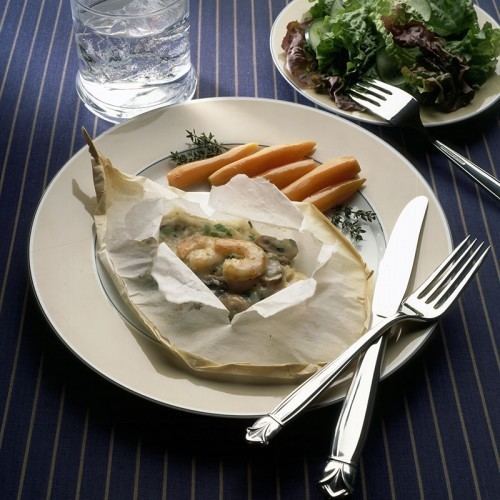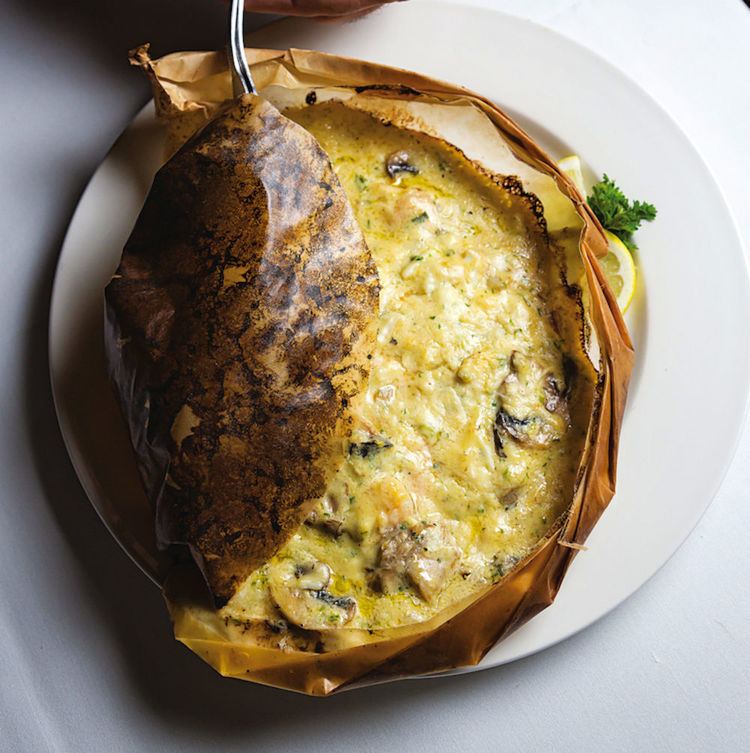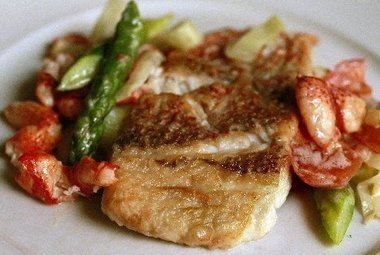 | ||
Similar Eggs Sardou, Oysters Bienville, Oysters en brochette, Calas, Oysters Rockefeller | ||
Pompano en Papillote is a dish created by Jules Alciatore at Antoine's Restaurant in New Orleans for a banquet honoring the Brazilian balloonist Alberto Santos-Dumont. The dish was based in turn on a dish that Jules's father Antoine Alciatore had created—Pompano Montgolfier--honoring the brothers who had created the first balloons. A filet of pompano is baked in a sealed parchment paper envelope with a white sauce of wine, shrimp, and crabmeat. With a bit of luck the steam will puff up the parchment a bit, suggesting a hot air balloon.

As a Symbol of New Orleans Grand Creole

It is tempting in the modern culinary world to view Pompano en Papillote with some derision—a gimmicky old warhorse of a bygone era. But it is important to understand its place in culinary history. It is in some ways the epitome of New Orleans grand Creole cooking; to understand the dish is to understand the cuisine and the nature of the grand dames of New Orleans restaurants.
The presentation of baked fish in a paper envelope is about theater and spectacle. There are no purely culinary reasons to do it. The same effect can be had by baking fish in a shallow dish with a tight lid. As long as the contents can be heated quickly and most of the steam retained, you will get the same basic dish. But grand restaurants are not simply about the food. At their best, they create a sense of specialness, of celebration, of achievement, and even a bit of mystique. Great restaurants today do this. Antoine's has been doing it since the mid 19th century. The presentation en papillote is an attention getter in the dining room, much like a soufflé has always been, and much like the now played-out towering architectural food of the 1990s was.
A tie to France is part of the very concept of New Orleans Creole. The city had come into the United States when Jefferson made the Louisiana Purchase in 1803—over a hundred years after its founding. It remained an American center for French culture, tradition, and immigration into the twentieth century. The velouté is one of the 'mother' sauces, foundational in French cuisine. New Orleans took from France, but also began to impart its own spin. The traditional seasoning in the French version would be diced onions (sauteed briefly), salt, white pepper, and a pinch of ground nutmeg. A bouquet garni consisting of parsley, bay leaf, and thyme may have been added to the shrimp stock. New Orleans chefs would have added more onion, a bit of garlic, and a pinch of cayenne pepper (or a splash of hot sauce) in addition to the white pepper, producing a spicier version compared to the classic. Not the tongue searing hotness that came out of the caricature of Cajun food in the 1980s, but rather a piquant that added interest.
The final driving force shaping the nature of New Orleans cooking was the richness of the local food products—in this case, pompano, shrimp, and lump crabmeat. New Orleans (and southern Louisiana) is uniquely situated. It is close to the Gulf of Mexico which yielded pompano, snapper, drum, trout, flounder, mackerel, shrimp, and sea turtle. But it is also part of the Mississippi River delta system and is just south of the wetlands abutting Lake Pontchartrain. From these regions came crab, crawfish, and oysters.
